The Nose
Probing the proboscis
Implicasphere
Implicasphere aims to explode the fixity of thought by choosing a single word—here, ‘nose’—and tracing the associations that ooze and spurt from it contagiously. We rifle through the nooks and crannies of human ideas, gathering fragments of texts and images excerpted in unadulterated form from sources as diverse as techno-science, contemporary art, cookery and medieval myth. Here we have picked our favorite noses and let them run. Following our individual implicaspheres has led us through unexpected terrain, and that which is, well, as plain as the nose on your face.
That laughable appendage is at the apex of what it is to be human. For Sigmund Freud the first human becomes so by raising erect, prising the nose away from the alluring stink of the animal, sexual zones of the body. That the nose and sexuality are complexly intertwined is hinted at by the priapic puppet Mr. Punch and made literal by syphilis sufferers who lose their nose to the ravages of infection. But these days we raise our noses further and further from the sexual mire. Anything more musky than vegetal smells seems to repulse the virtually anosmic Westerner: we no longer ask our lover, as Napoleon did, not to wash for a fortnight before we meet.
The nostrils are points of entry to and exit from the body. In parts of South America the tapir is thought to copulate and excrete through its snout. Then there is the Tacan myth of a man who nuzzles into an armadillo burrow and tumbles into a realm of dwarves with no anuses, who feed on smells rather than solids for fear of bursting. In paranormal accounts the nostrils are gateways to the seat of consciousness, which may be entered by supernatural entities or meddlesome devils. A contemporary equivalent might be the enduring practice of snorting mind-altering substances.
The nose has been the subject of violence throughout history. Phrenological interpretations of its shape helped usher in the genocidal body politics of Nazism, ‘mayhem’ originally meant to bite off the nose or ears and ancient forms of rhinoplasty were developed in Eastern cultures where nose decapitation was the punishment for adultery—a literal case of cutting the nose off to spite the pretty face. To lose one’s nose is to produce a crisis of identity. And so it is that Laurence Sterne’s Tristram Shandy is set for a life of ill fortune after his nose is crushed by the forceps that drag him into the world. In Nikolai Gogol’s famous story the detached nose rivals its original possessor, while over-large appendages trouble Pinocchio, Cyrano de Bergerac and Ryunosuke Akutagawa’s monk. In the movies, too, the loss or engorgement of the nose provides dark symbolism and provokes bizarre quests. Take, for instance, Jack Nicholson’s bandaged nose, which identifies him as a snoop in Roman Polanski’s Chinatown, or Woody Allen and Diane Keaton’s theft of the president’s nose, from which he was to be cloned, in Sleeper. So, thwarted from the start, maybe, we have tried to absorb on a single sheet endless radiating droplets of association, to net these constantly escaping noses and capture the sneeze of an idea.
I am, that is to say I was, a great man, but I am neither the author of Junius nor the man in the mask, for my name, I believe, is Robert Jones, and I was born somewhere in the city of Fum-Fudge.
The first action of my life was the taking hold of my nose with both hands. My mother saw this and called me a genius:—my father wept for joy and presented me with a treatise on Nosology. This I mastered before I was breeched.
I now began to feel my way in the science, and soon came to understand that, provided a man had a nose sufficiently conspicuous, he might by merely following it, arrive at a Lionship. But my attention was not confined to theories alone. Every morning I gave my proboscis a couple of pulls and swallowed a half-dozen of drams.
When I came of age my father asked me, one day, if I would step with him into his study.
“My son,” he said, when we were seated, “what is the chief end of your existence?”
“My father,” I answered, “it is the study of Nosology.”
“And what, Robert,” he inquired, “is Nosology?”
“Sir,” I said, “it is the science of Noses.”
“And can you tell me,” he demanded, “what is the meaning of a nose?”
“A nose, my father,” I replied, greatly softened, “has been variously defined by about a thousand different authors.” [Here I pulled out my watch.] “It is now noon, or thereabouts—We shall have time enough to get through with them all before midnight. To commence then: The nose, according to Bartholinus, is that protuberance—that bump—that excresence—that—”
“Will do, Robert,” interrupted the old gentleman. “I am thunderstruck at the extent of your information—I am positively—upon my soul.” [Here he closed his eyes and placed his hand upon his heart.] “Come here!” [Here he took me by the arm.] “Your education may now be considered as finished—it is high time you should scuffle for yourself—and you cannot do a better thing than merely follow your nose–so–so–so–” [Here he kicked me down stairs and out of the door.]—“So get out of my house, and God bless you!”
As I felt within me the divine afflatus, I considered this accident rather fortunate than otherwise. I resolved to be guided by the paternal advice. I determined to follow my nose. I gave it a pull or two upon the spot, and wrote a pamphlet on Nosology forthwith.
—Edgar Allan Poe, “Lionizing,” Southern Literary Messenger, May 1835.
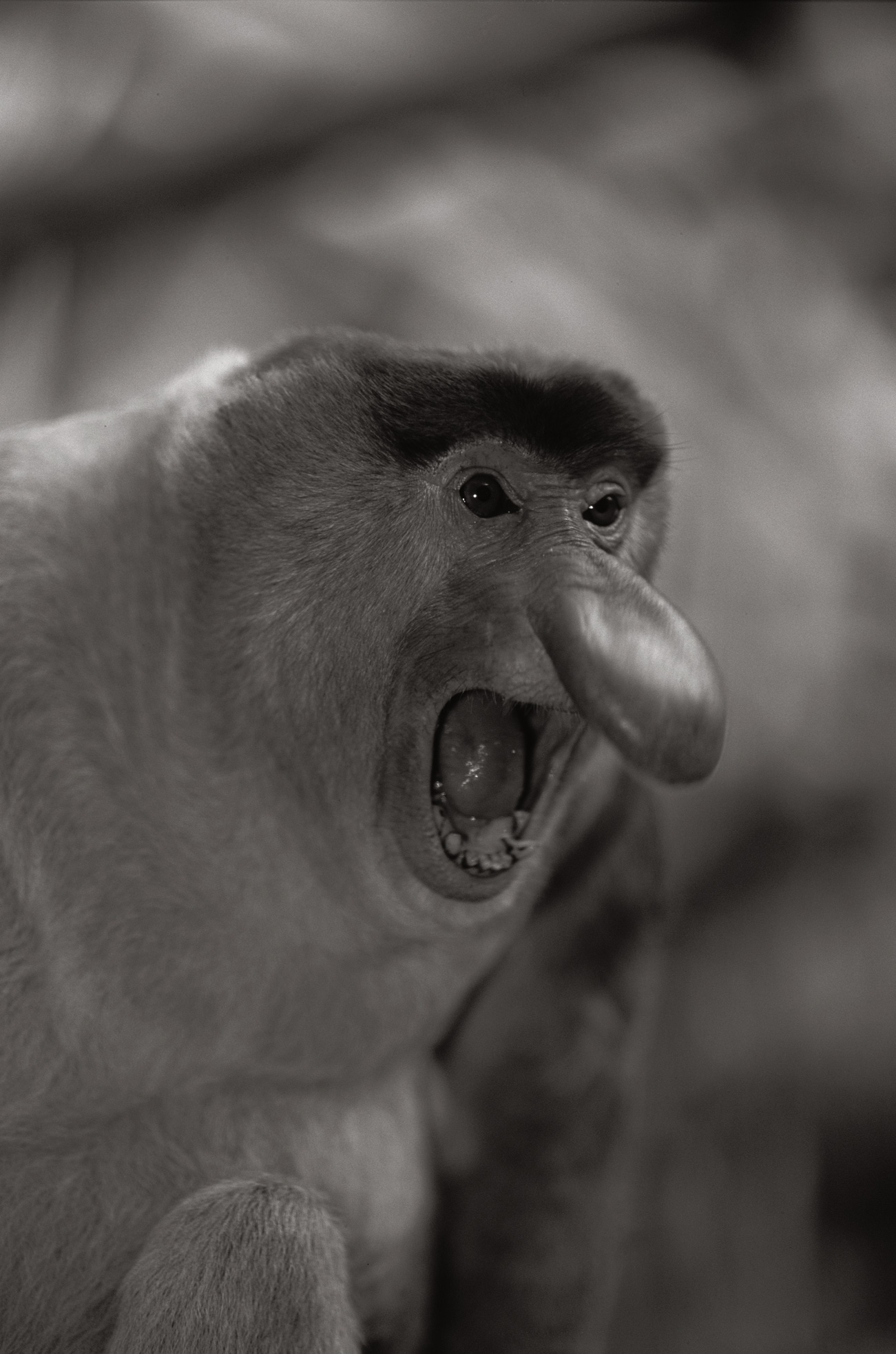
For exaggeration to be comic, it must not appear as an aim, but rather as a means that the artist is using in order to make manifest to our eyes the distortions which he sees in embryo. It is this process of distortion that is of moment and interest. And that is precisely why we shall look for it even in those elements of the face that are incapable of movement, in the curve of the nose or the shape of an ear. For, in our eyes, form is always the outline of movement. The caricaturist who alters the size of a nose, but respects its ground plan, lengthening it, for instance, in the very direction in which it was being lengthened by nature, is really making the nose indulge in a grin. Henceforth we shall always look upon the original as having determined to lengthen itself and start grinning.
—Henri Bergson, Laughter: An Essay on the Meaning of the Comic, trans. Cloudesley Brereton and Fred Rothwell (London: MacMillan, 1911).
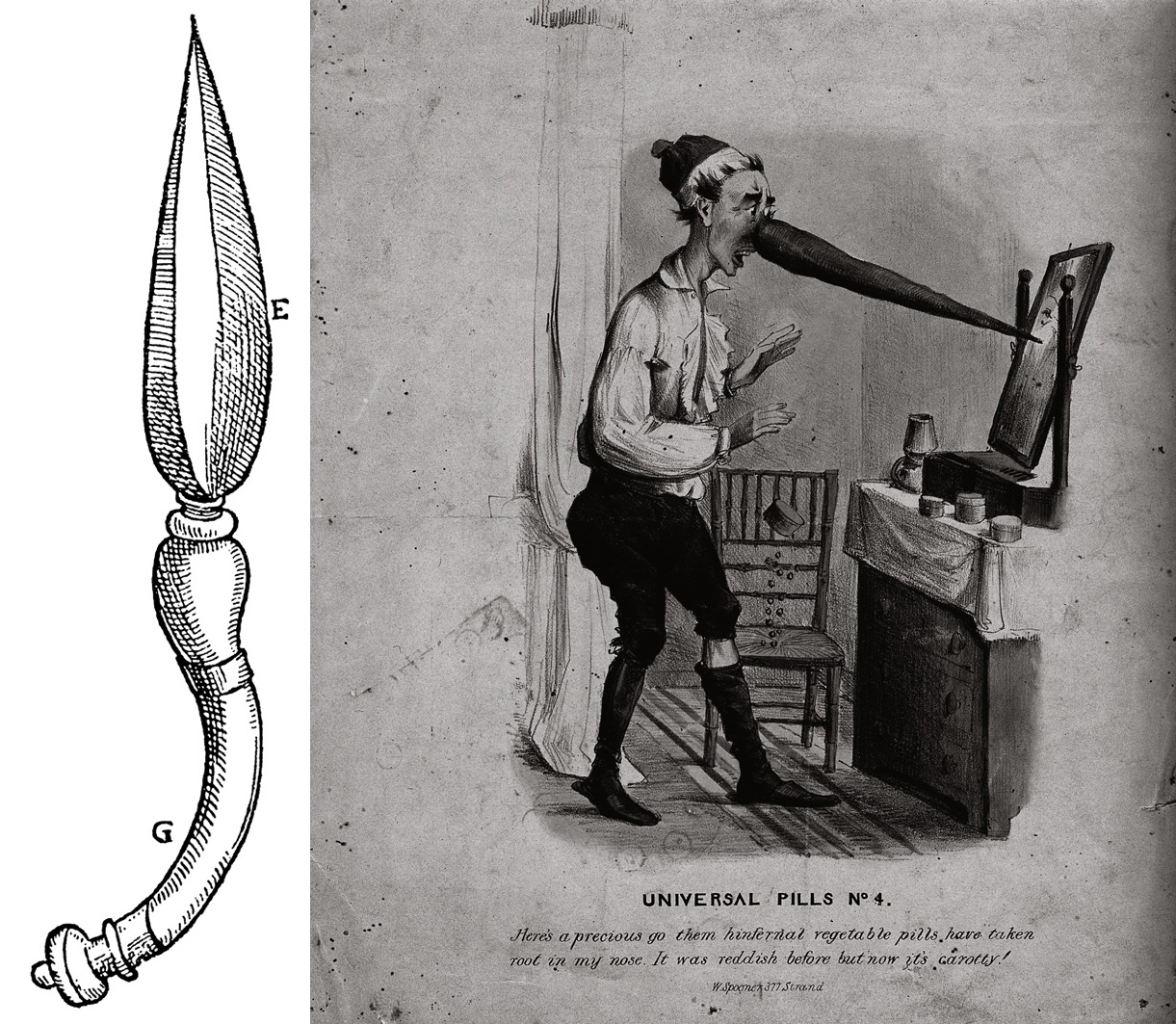
I have often had a suspicion that something organic plays a part in repression; I was able once before to tell you that it was a question of the abandonment of former sexual zones ... (The notion was linked to the changed part played by the sensations of smell: upright walking, nose raised from the ground, at the same time a number of formerly interesting sensations attached to the earth becoming repulsive—by a process still unknown to me.) (He turns up his nose = he regards himself as something particularly noble.) Now, the zones which no longer produce a release of sexuality in normal and mature human beings must be the regions of the arms and of the mouth and throat. This is to be understood in two ways: first, that seeing and imagining these zones no longer produce an exciting effect, and second, that the internal sensations arising from them make no contribution to the libido, the way the sexual organs proper do. In animals these sexual zones continue in force in both respects; if this persist in human beings too, perversion results. We must assume that in infancy the release of sexuality is not yet so much localized as it is later, so that the zones which are later abandoned (and perhaps the whole surface of the body as well) also instigate something that is analogous to the later release of sexuality. The extinction of these initial sexual zones would have a counterpart in the atrophy of certain sexual organs in the course of development ... [If a memory of ‘excitations of abandoned sexual zones’ is triggered, the outcome] is not a release of libido but of an unpleasure, an internal sensation analogous to disgust in the case of an object.
To put it crudely, the memory actually stinks; and in the same way as we turn away our sense organ (the head and the nose) in disgust, the preconscious and the sense of consciousness turn away from the memory. This is repression.
—Sigmund Freud, letter to Wilhelm Fliess, Vienna, November 14, 1897. From The Complete Letters of Sigmund Freud to Wilhelm Fliess, 1887–1904, trans. and ed. Jeffrey Moussaief Masson (Cambridge, MA: Belknap Press of Harvard University Press, 1985).
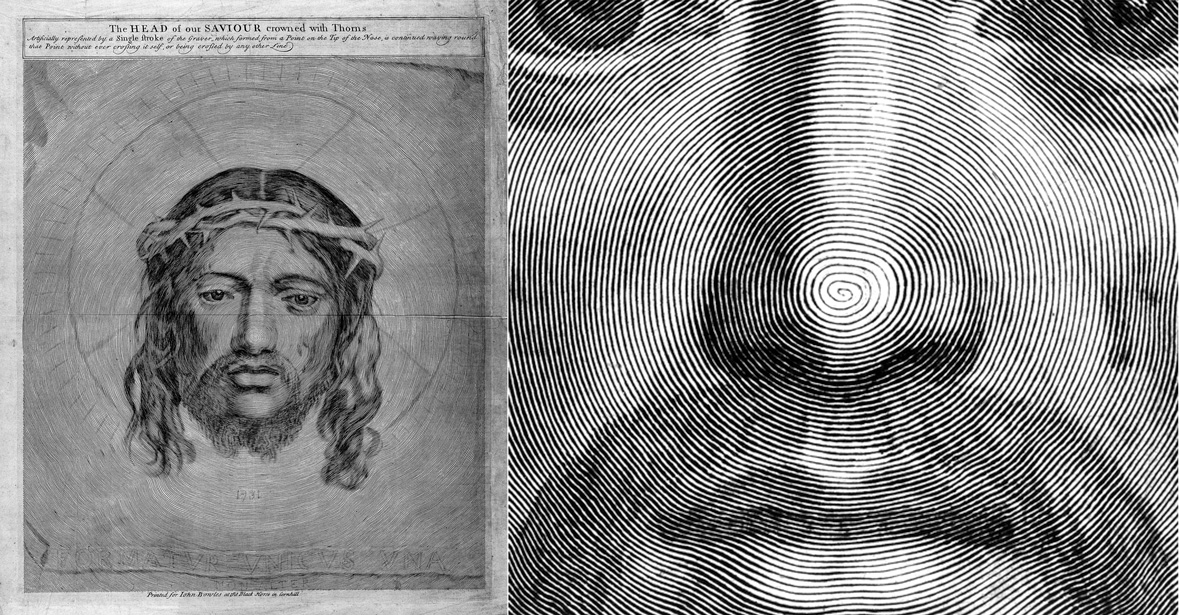
“You don’t understand,” he said, “who I am or what I am. I’ll show you. By Heaven! I’ll show you.” Then he put his open palm over his face and withdrew it. The centre of his face became a black cavity. “Here,” he said. He stepped forward and handed Mrs. Hall something which she, staring at his metamorphosed face, accepted automatically. Then, when she saw what it was, she screamed loudly, dropped it, and staggered back. The nose—it was the stranger’s nose! pink and shining—rolled on the floor.
Then he removed his spectacles, and everyone in the bar gasped. He took off his hat, and with a violent gesture tore at his whiskers and bandages. A flash of horrible anticipation passed through the bar. “Oh, my Gard!” said some. Then off they came.
It was worse than anything. Mrs. Hall, standing open-mouthed and horrorstruck, shrieked at what she saw, and made for the door of the house. Everyone began to move. They were prepared for scars, disfigurements, tangible horrors, but nothing! The bandages and false hair flew across the passage into the bar, making a hobbledehoy jump to avoid them. Every one tumbled on every one else down the steps. For the man, who stood there shouting some incoherent explanation, was a solid gesticulating figure up to the coat-collar of him, and then—nothingness, no visible thing at all!
—H. G. Wells, The Invisible Man (London: C. Arthur Pearson, 1897).
Talk ought always to run obliquely, not nose to nose with no chance of mental escape.
—Frank Moore Colby, “Simple Simon,” The Colby Essays (New York: Harper & Brothers, 1926).
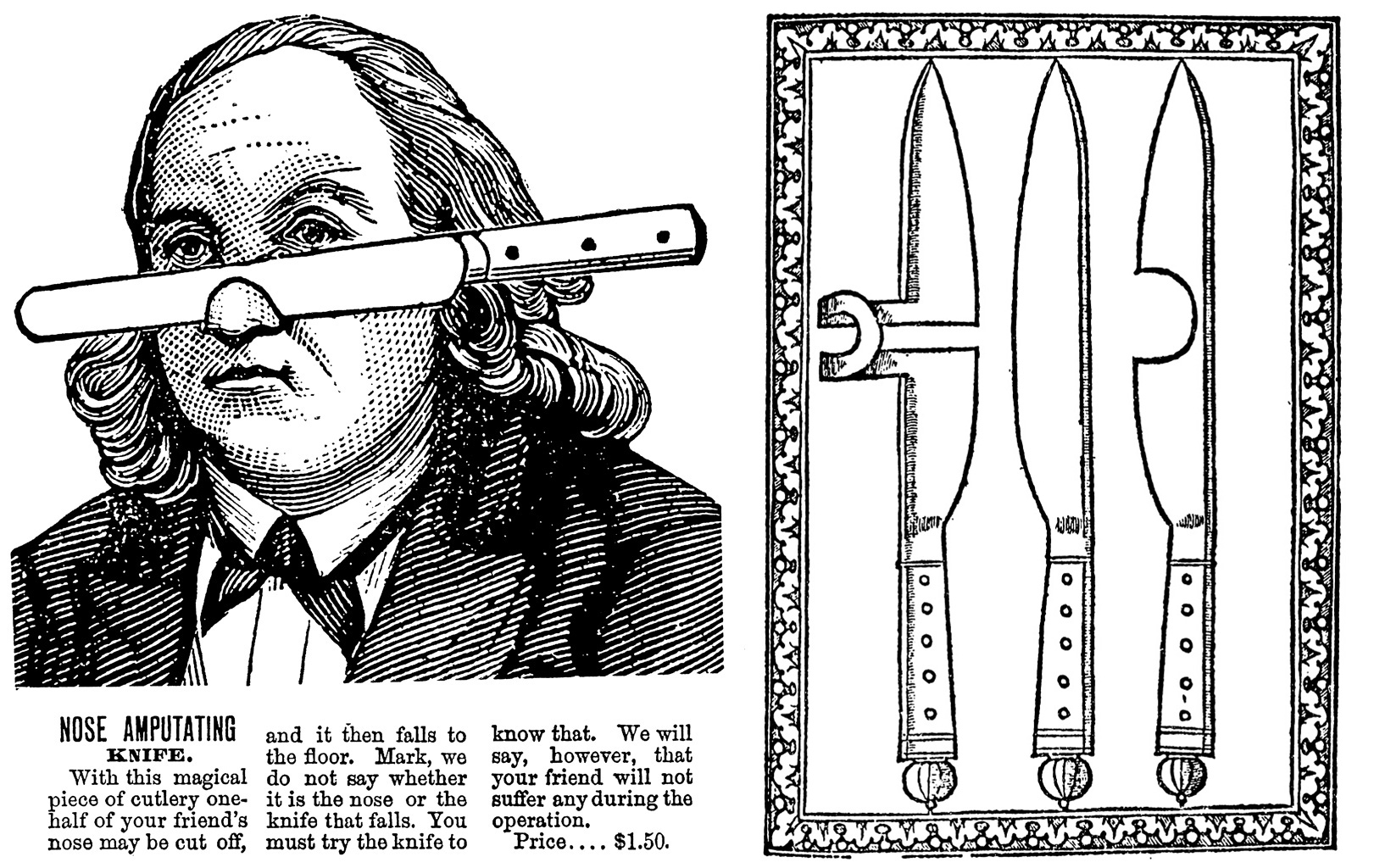
To dream one has a fair and great nose is good to all; for it signifies subtlety of sense, providence in affairs, and acquaintance with great personages. But to dream one has no nose, signifies the contrary; and to a sick man death, for dead men’s heads have no nose. If anyone dreams his nose is longer than ordinary, he will become rich and powerful, provident and subtile, and be well received among grandees. To dream one has two noses signifies discord and quarrels, especially with his domestic kindred. If one dreams that his nose is grown so big that it is hideous to the sight, he will live in prosperity and abundance, but never gain the love of the people. If anyone dreams his nose is stopped, so that he has lost his scent—if he be a king, he is in some imminent danger from him that hath the greatest authority about his person. If it be a private person, he is in danger of being deceived by his wife, who will commit herself with one of the servants.
—Edward Frank Allen, The Complete Dream Book (Philadelphia: The Blakiston Company, 1938).
It’s true that one must value gifts in relation to those who offer them; when a peasant gives me his bit of cheese he’s making me a bigger present than the Prince of Làscari when he invites me to dinner. That’s obvious. The difficulty is that the cheese is nauseating. So all that remains is the heart’s gratitude which can’t be seen and the nose wrinkled in disgust which can be seen only too well.
—Giuseppe Tomasi di Lampedusa, The Leopard, trans. Archibald Colquhoun (London: Collins and Harvill Press, 1960).
There is a profound link between conjuring and rhinoplasty that is rooted in the legends of sympathetic magic. After a graft from the arm to the nose, for instance, when the arm is injured the nose falls to the ground. A number of versions of this apparently popular conceit are discussed in Lynn Thorndike’s History of Magic and Experimental Science, in eight volumes (New York, 1923–58): Francis Bacon tells of men with large and ugly noses who have cut off the excess flesh and then healed the wounds by making a gash in their arms and holding their noses there for a time, “which, if it be true, shows plainly the consent of flesh for flesh.” On the same theme is the story of a reconstructed nose that putrified when the donor of the flesh died. Caspar Schott, who doubted this often told tale, nonetheless credited the restoration of a nose achieved by putting it in cold water or snow (quoting Daniel Schwenter’s Deliciæ physica mathematicæ [Nuremberg, 1639]). In Hudibras, Samuel Butler was not above having some more fun with this superstition—and even more fun with the notion of supplying the new organ from a volunteer’s bottom.
So learned Taliacotius from
The brawny part of a porter’s bum
Cut supplemental noses, which,
Would last as long as the patient’s breech,
But when the date of Nock was out
Off dropt the sympathetic snout.
Both Schott and Schwenter, well known for their contributions to the literature of performance magic, waxed poetic on wobbly noses. Schott propounded (although later he rejected the theory) that demons could produce “some animals from putrid matter and that if a murderer approached his victim the corpse would bleed.” (This superstition is linked specifically to the nose in Humphrey Wanley’s Wonders of the Little World [London, 1678], where it is reported that in 1632 a man had murdered his very pregnant wife, whose child was then laid out beside her. When the husband viewed the corpses, the baby’s began to bleed from the nose—thereby implicating the husband.) However, Schott did question the tale of the nose that putrified when its donor died. Stories from many primitive cultures, in which demons, devils, and dybbuks enter the body through the nostrils, are recounted in Doctor Harold Holden’s Noses (Cleveland and New York, 1950).
—From Ricky Jay, Jay’s Journal of Anomalies (New York: Farrar, Straus and Giroux, 2001).
The bitter, the hollow and—haw! haw!—the mirthless. The bitter laugh laughs at that which is not good, it is the ethical laugh. The hollow laugh laughs at that which is not true, it is the intellectual laugh. Not good! Not true! Well, well. But the mirthless laugh is the dianoetic laugh, down the snout—haw!—so. It is the laugh of laughs, the risus purus, the laugh laughing at the laugh, the beholding, the saluting of the highest joke, in a word the laugh that laughs—silence please—at that which is unhappy.
—Samuel Beckett, Watt (Paris: The Olympia Press, 1958).
Insects generally do not utilize active ventilation. They just let the air move in and out of the spiracles passively. They do have muscles that can be used to close the spiracles when necessary to reduce airflow. When insects need additional oxygen in their system, they increase airflow by telescoping the abdomen. This is much like physically forcing air into and out of human lungs by chest compression during CPR. Because insects don’t need to force air into lungs like mammals, they don’t have noses. They do have a proboscis, however. Some human noses of rather large size have sometimes been humorously called proboscises. Insects do have proboscises, but they aren’t used for breathing. An insect proboscis is just used for eating!
—Tom Turpin, “Insect Breathing Not Dependent on Noses,” from “On Six Legs,” column published by the College of Agriculture, Purdue University, 23 January 2003.

October 6, 2004: Onboard the space station, astronauts are surrounded by ammonia. It flows through pipes, carrying heat generated inside the station (by people and electronics) outside to space. Ammonia helps keep the station habitable.
But it’s also a poison. And if it leaks, the astronauts will need to know quickly. Ammonia becomes dangerous at a concentration of a few parts per million (ppm). Humans, though, can’t sense it until it reaches about 50 ppm.
Ammonia is just one of about forty or fifty compounds necessary on the shuttle and space station, which cannot be allowed to accumulate in a closed environment.
And then there’s fire. Before an electrical fire breaks out, increasing heat releases a variety of signature molecules. Humans can’t sense them either until concentrations become high.
Astronauts need better noses!
That’s why NASA is developing the Electronic Nose, or ENose for short. It’s a device that can learn to recognize almost any compound or combination of compounds. It can even be trained to distinguish between Pepsi and Coke. Like a human nose, the ENose is amazingly versatile, yet it’s much more sensitive. …
Here’s how it works: ENose uses a collection of 16 different polymer films. These films are specially designed to conduct electricity. When a substance—such as the stray molecules from a glass of soda—is absorbed into these films, the films expand slightly, and that changes how much electricity they conduct.
Because each film is made of a different polymer, each one reacts to each substance, or analyte, in a slightly different way. And, while the changes in conductivity in a single polymer film wouldn’t be enough to identify an analyte, the varied changes in 16 films produce a distinctive, identifiable pattern.
Electronic Noses are already being used on Earth. In the food industry, for example, they can be used to detect spoilage. There’s even an Electronic Tongue, which identifies compounds in liquids. NASA’s ENose needs to be able to detect lower concentrations than these devices.
—n.a., “Electronic Nose,” NASA Science. Available at science.nasa.gov/science-news/science-at-nasa/2004/06oct_enose.
I want to kiss God on His nose and watch Him sneeze
and so do you.
Not out of disrespect.
Out of pique.
Out of a man-to-man thing.
—Anne Sexton, “Jesus Dies,” in Anne Sexton, The Complete Poems (Boston: Houghton Mifflin Company, 1999).
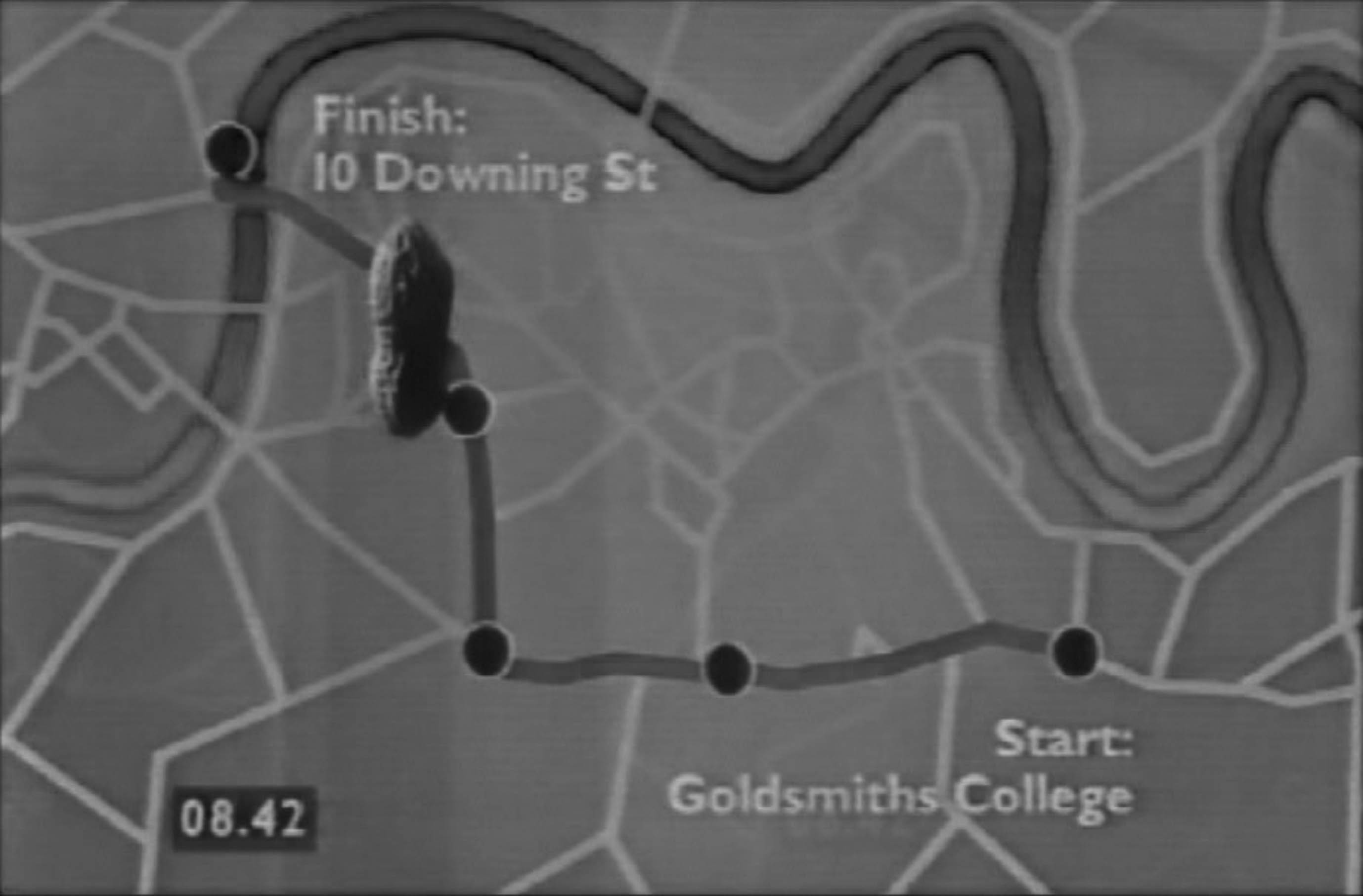
Better a snotty child than his nose wiped off.
—George Herbert, “Outlandish Proverbs,” in The Works of George Herbert, ed. F. E. Hutchinson (Oxford: Clarendon Press, 1941).
Cleopatra’s nose: had it been shorter, the whole aspect of the world would have been altered.
—Blaise Pascal, Pensées, no. 162, trans. W. F. Trotter (New York: E. P. Dutton and Company, 1958).
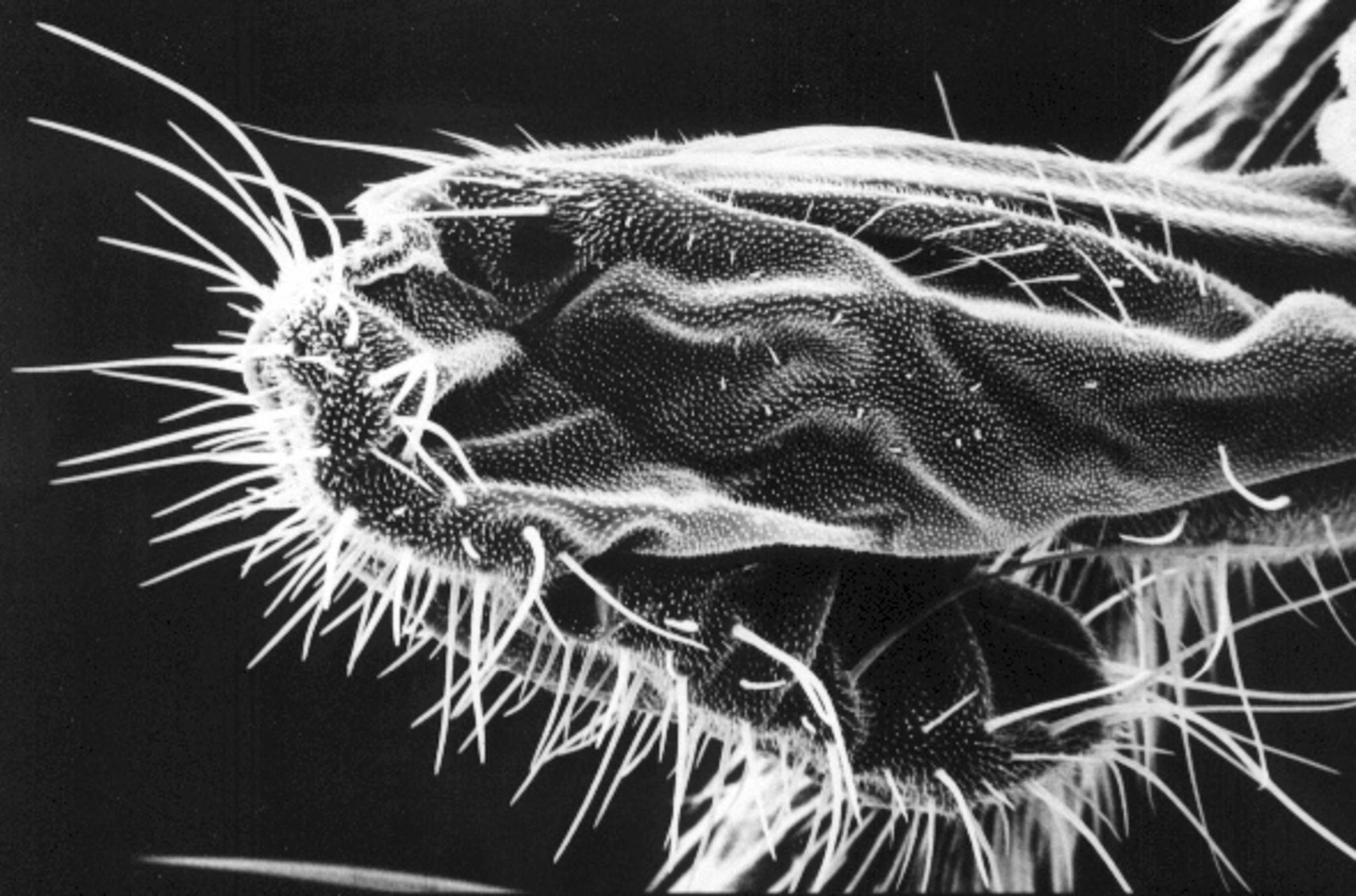
Yesterday, Daisy Mae and Biff were grooving on the street
And just like in a movie, her hands became her feet
Her belly button was her mouth
Which meant she tasted what she’d speak
But the funny thing is what happened to her nose
It grew until it reached all of her toes
Now when people say her feet smell they mean her nose
—Lou Reed, “Andy’s Chest,” 1969.
When men first came together in society, and of course required rules and regulations to preserve them so, it became immediately established, “That the will of the greater number should be esteemed the will of the whole,”—an allowance founded upon this obvious reason, “That as the majority was the strongest side, the other might as well peaceably submit.” The next necessary measure then, was to find out some mode, by which this will should be made known and ascertained.—The body, which is the dial of the mind, was had recourse to—every part of it has been put to trial, until at length, for many wise and potent reasons, the nose hath been decreed, by tacit approbation, to be the most convenient indicating member. That it does answer purpose, merely, will, I presume, be easily granted; for every man is, prima facie, in the possession of a nose, more or less; besides the fact, which stares us in the face, puts at once the matter out of doubt. But whether the purpose is thus best answered, or why this feature should have stood the test, in preference to every other part of the human frame, is the question, that weighs down the well-fledged eyebrow with considerance. …
With respect to the policy of the custom now under consideration; men have always been careful, that if they cannot assume the semblance of virtue in the commission of a bad action, they may at least avoid, betraying any signs of vice. … Conscience however, placed in the breast of man, as the advocate of truth, was found to be an overmatch for the busy agents of her enemies. Falsehood was accompanied by this disprover, wherever she went; the tongue faultered, when its office was perverted; the lips trembled, when they face an unjust utterance; the hand shook, when it threw in the suffrage that had been basely bartered for and sold … The nose, then, very naturally occurred, as being a uniform, steady friend, that might with safety be depended on; not subject to be thrown into emotion, from the calls of conscience, nor of course to be easily put out of countenance. …
Men in the military line, who have lost their legs or arms in the service of their country, may, perchance, through singular luck, and much interest, be able to get as much as will maintain them in wooden legs and slings for the rest of their lives; but in the civil line, the nose is the fina qua non of preferment; the loss of it is fatal to the owner. It is the instrument of negociation—the political broker; hence Government is frequently said “to pay thro’ the nose for such a thing.” This being the medius terminus; that is, Madam, the go-between as it were, or middle-agent, that brings things together and does the business for both parties.
—[n.a], A Treatise on the Custom of Counting Noses (London: Printed for G. Kearsly, 1779).
For the sake of decency Ivan Yakovlevich put a coat on top of his night shirt, and seating himself at the table, poured out some salt, peeled two onions, took hold of a knife and, with an air of the utmost gravity, set about slicing his loaf. Cutting it in half he glanced inside and, to his great surprise, saw something white. He cautiously prodded it with his knife and poked it with his finger. “Feels firm,” he thought, “what on earth can it be?”
He stuck in his fingers and pulled out—a nose!.. At this his hands fell to his sides, he then rubbed his eyes and felt the object: yes, a nose, no doubt about it! And even, it seemed a familiar nose. An expression of horror was nothing compared to the indignation that overtook his lady wife.
“Where did you cut off that nose, you butcher?” she shrieked, livid with rage. “You villain! Drunkard! I’ll report you to the police myself. Downright criminal! I’ve already been told by three people how you tug at their noses so hard while you’re shaving them that it’s a wonder they stay on at all.”
But Ivan Yakovlevich was struck dumb. He had recognised the nose as belonging to none other than Collegiate Assessor Kovalev, whom he shaved every Wednesday and Sunday.
“Wait, Praskovya Osipovna! I’ll wrap it up in a cloth and put it over there in the corner: let it sit there for a little while, then I’ll take it away.”
“Not another word! You think that I’d allow a cut-off nose to sit in my room?.. You numskull! All you’re good at is stropping your razor, and soon you won’t be able to do your job at all, you stupid oaf! You scoundrel! You think I’m going to stand up for you to the police?.. No fear, you good-for-nothing, you blockhead! Take it away! Away! Wherever you like, just don’t let me set eyes on it again!”
Ivan Yakovlevich stood there dumbfounded. He racked his brains, feeling utterly flummoxed. “Devil knows how it happened,” he said finally, scratching behind his ear. “Perhaps I came home drunk last night, or perhaps not, I can’t say. But on the face of it this is altogether ridiculous; I mean, bread is something you bake and a nose is nothing of the kind. It’s a mystery to me!..”
—Nikolai Gogol, “The Nose,” in Nikolai Gogol, Plays and Petersburg Tales, trans. Christopher English (Oxford: Oxford University Press, 1998).
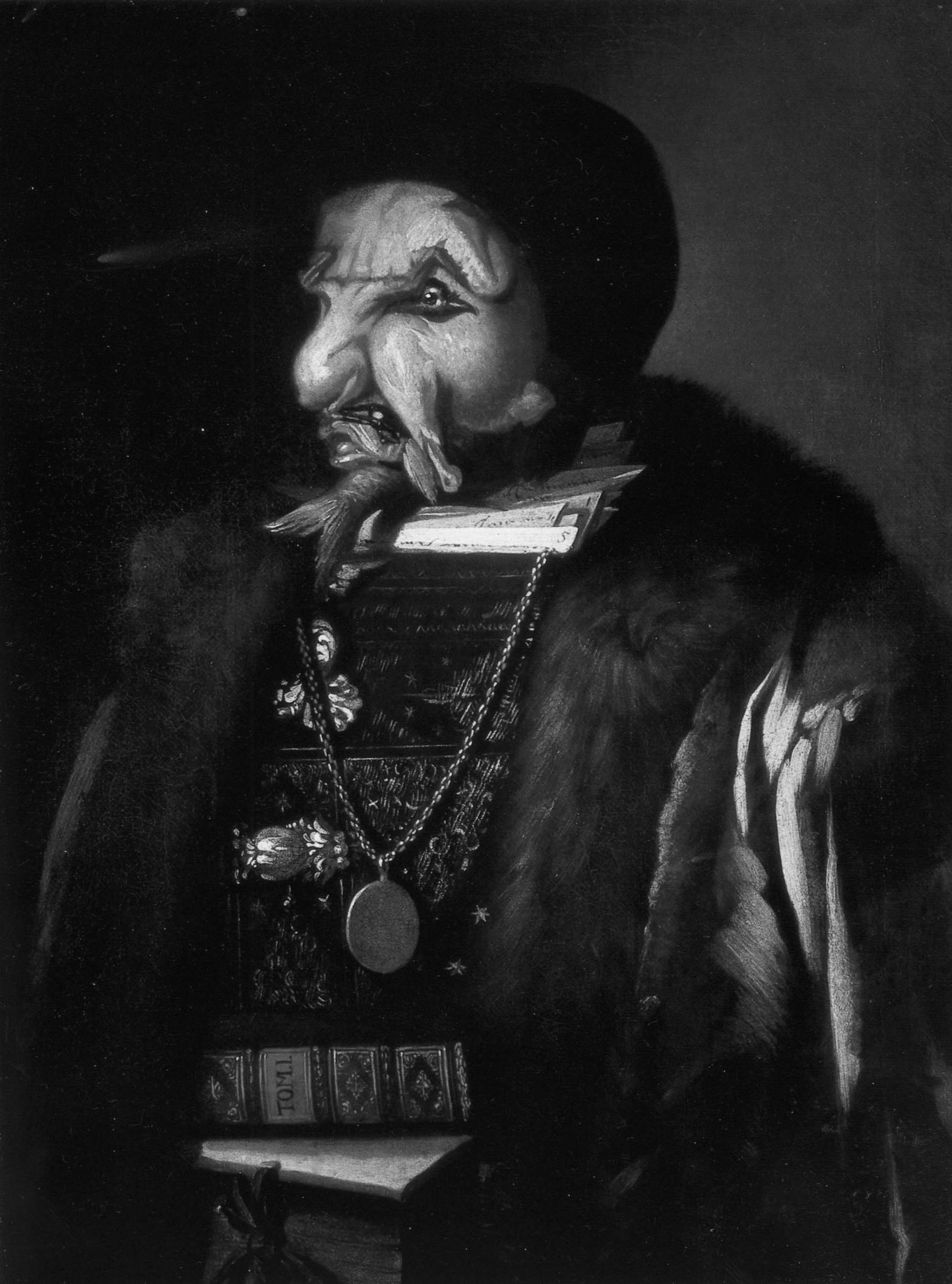
A team of Australian drug sniffer dogs has been sent back for retraining, after it was found they could only track talcum powder, not cocaine.
Melbourne police found that the white powder used to hone the dogs’ nostrils was not in fact an illegal substance. A probe is now under way to see whether any illicit drugs have gone missing.
“They’re very good at detecting talcum powder,” joked Assistant Commissioner Paul Evans. “If there’s any missing kids, we’ll find them fairly quickly.”
The seven dogs had been in training since January. They are meant to sit down next to a person when they detect the scent of cocaine.
Unfortunately, the dogs have yet to smell the drug, since the bag of white powder supplied by the Australian Federal Police for the canine training turned out to be talcum powder. Police in Victoria have launched an inquiry to see whether any cocaine has gone missing.
—BBC News Online World Edition, Asia-Pacific, Saturday 21 May 2005.
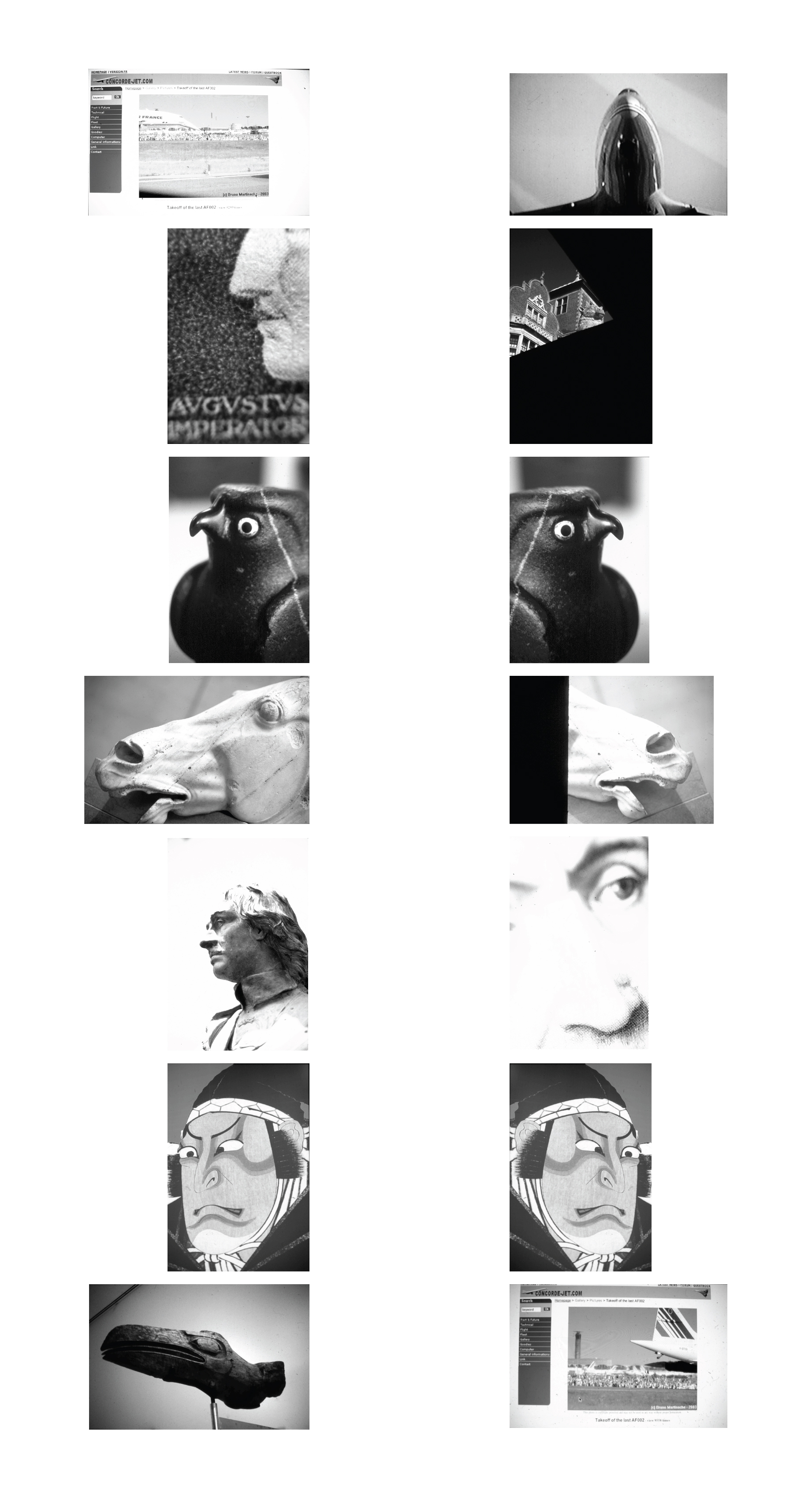
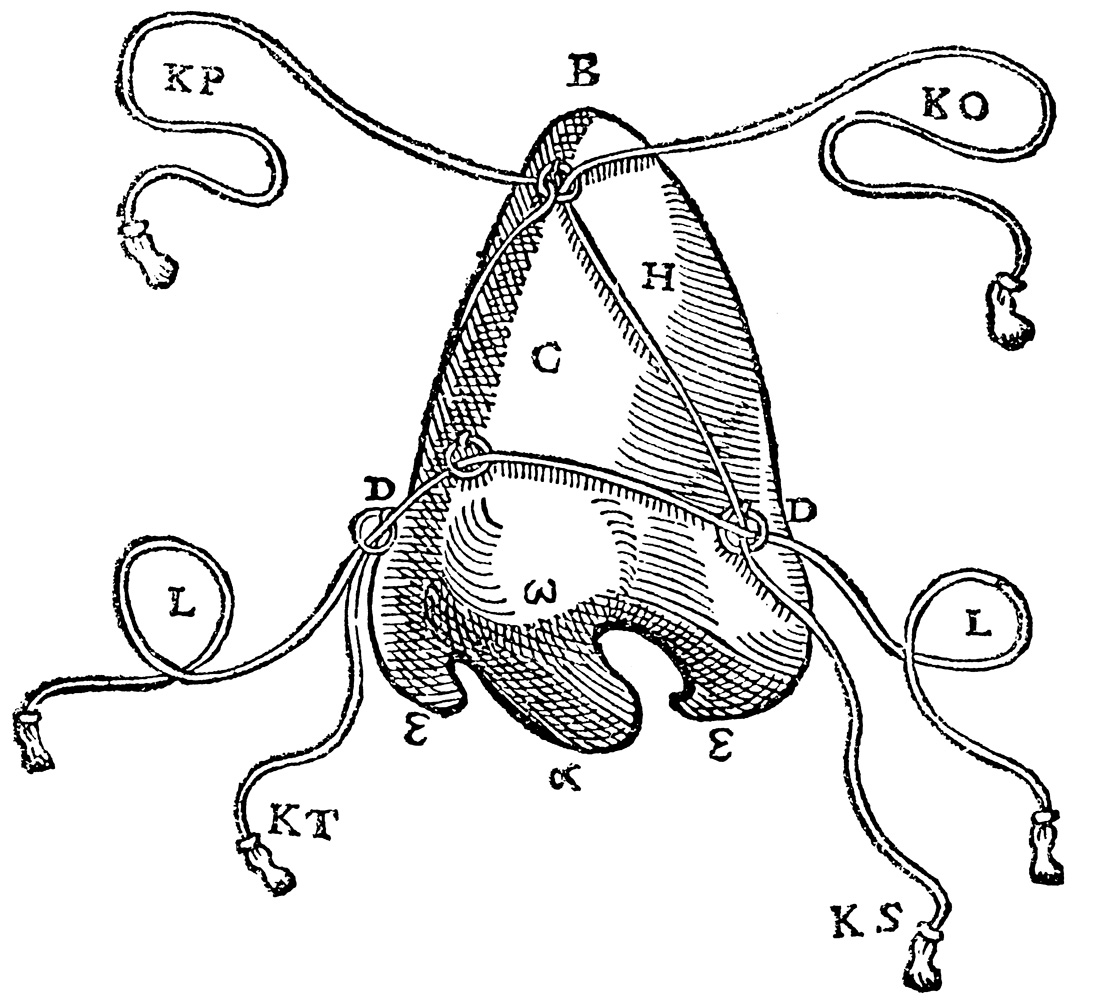
Breaths come in pairs, except at two times in our lives—the beginning and the end. At birth, we inhale for the first time; at death, we exhale for the last. In between, through all the lather of one’s life, each breath passes over our olfactory sites. Each day, we breathe about 23,040 times and move around 438 cubic feet of air. It takes us about five seconds to breathe—two seconds to inhale and three seconds to exhale—and, in that time, molecules of odor flood through our systems. Inhaling and exhaling, we smell odors. Smells coat us, swirl around us, enter our bodies, emanate from us. We live in a constant wash of them. Still, when we try to describe a smell, words fail us like the fabrications they are. … If there are words for all the pastels in a hue—the lavenders, mauves, fuschias, plums, and lilacs—who will name the tones and tints of a smell? It’s as if we were hypnotized en masse and told to selectively forget. It may be, too, that smells move us so profoundly, in part, because we cannot utter their names. In a world sayable and lush, where marvels offer themselves up readily for verbal dissection, smells are often right on the tip of our tongues—but no closer—and it gives them a kind of magical distance, a mystery, a power without a name, a sacredness.
—Diane Ackerman, A Natural History of the Senses (New York: Vintage Books, 1995).
CYRANO: That’s enough from you. Sho off!
THE BORE: But!
CYRANO: Fly! Or does my nose amuse your worship?
THE BORE: I—
CYRANO: What’s wrong with it?
THE BORE: Nothing your grace.
CYRANO: You’re drunk, if you assert it dangles like a trunk!
THE BORE: Far from it.
CYRANO: Or a beak an owl might sport?
THE BORE: I—
CYRANO: —or perchance disfigured by a wart.
THE BORE: But—
CYRANO: —a fly promenades about the feature or it is—
THE BORE: Sir!
CYRANO: Clean contrary to nature?
THE BORE: I never looked; since there was naught to stare for!
CYRANO: You never looked! Explain the why and wherefore!
THE BORE: I swear.
CYRANO: The thing disgusts you.
THE BORE: Sir!
CYRANO: You mean the colour’s foul.
THE BORE: Dear Sir!
CYRANO: The shape’s obscene!
THE BORE: Certainly not!
CYRANO: Then why so critical? Is it a trifle large perhaps?
THE BORE: It’s small. Tiny; indeed I’d call it microscopic!
CYRANO: What, would you vent your humour on this topic? You dare to call it small.
THE BORE: God!
CYRANO: You snub-nosed dolt, such vastness can’t deform us! ’Tis my delight to face the world thus snouted, for none but fools like you have ever doubted that a great nose argues its owner lavish, gentle brave, like me, and not knavish nincompoop such as you, whose featureless face, which serves no purpose but its own disgrace and some small entertainment for these fingers, is as devoid—[boxes his ear]
THE BORE: Stop it!
—Edmond Rostand, Cyrano De Bergerac, trans. Humbert Wolfe (London: Hutchinson & Co., 1937).
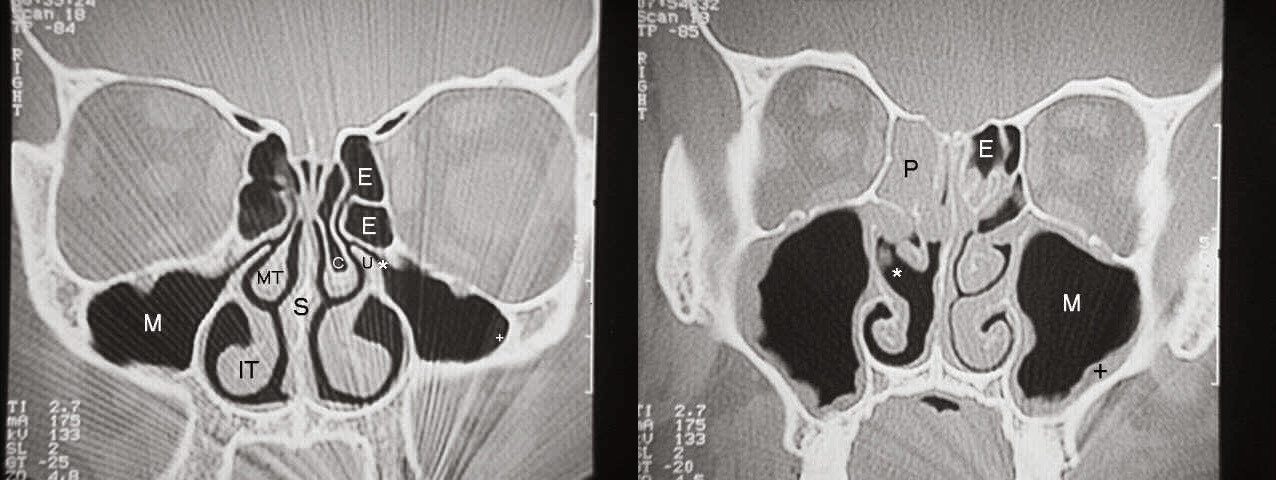
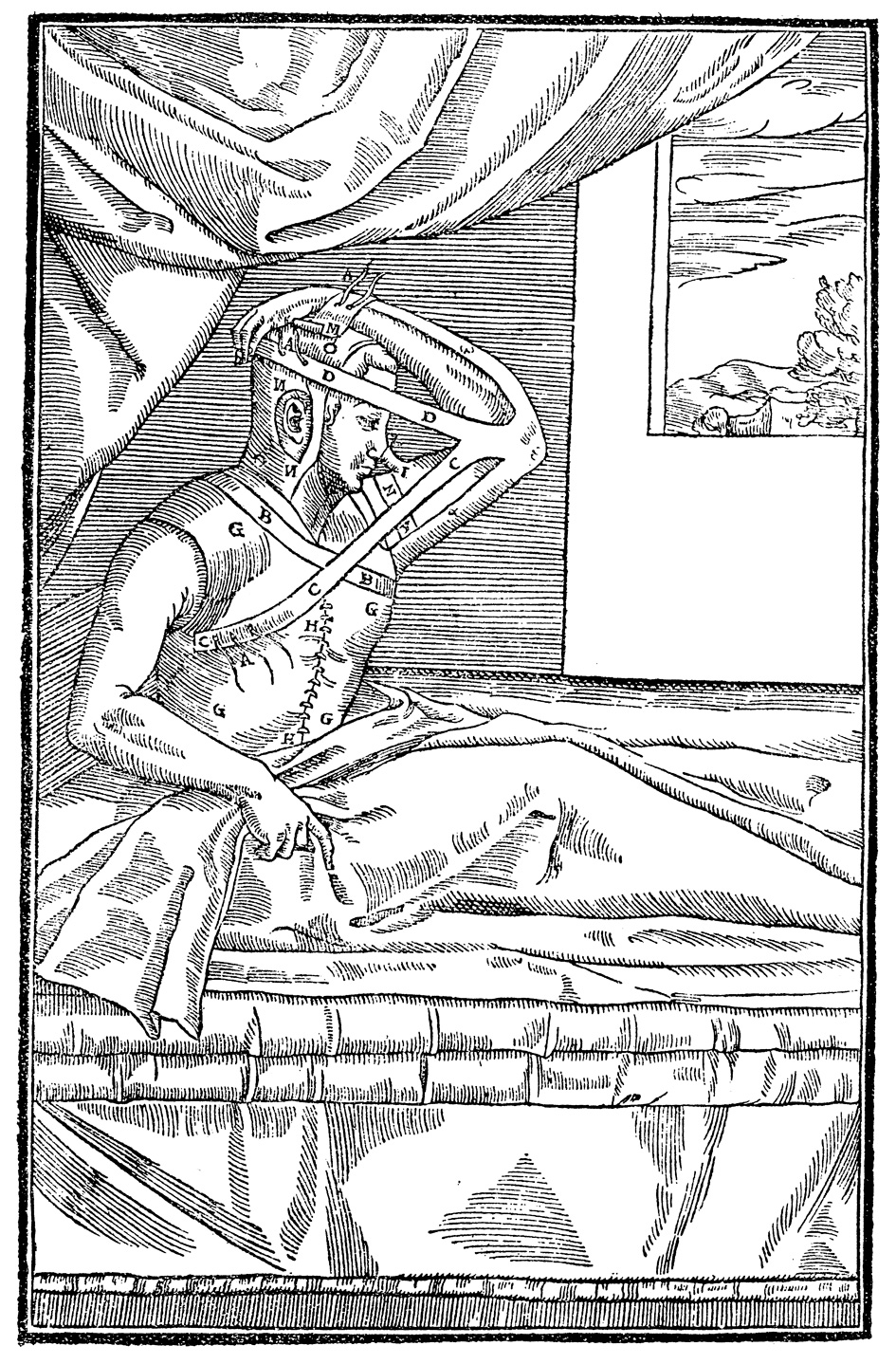
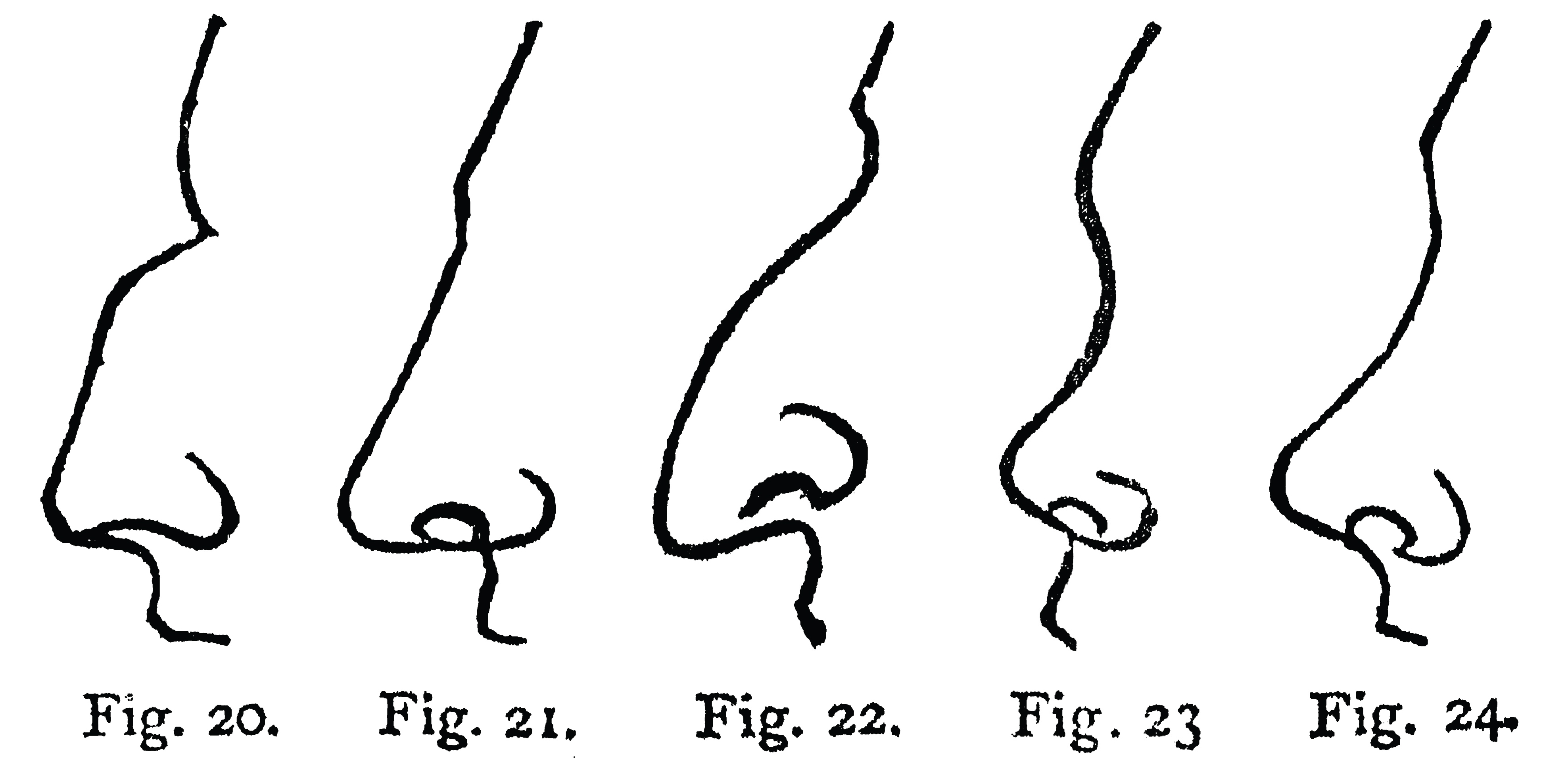
THE NOSE, being the most prominent feature on the face, ought to have some character in it, and it is generally conceded that it has. …
The nose may be classified as follows:–
1. The Roman Nose,
2. The Greek Nose,
3. The Jewish Nose,
4. The Snub Nose, and
5. The Celestial Nose.
This classification is based on the profile alone, and there may be almost endless modifications of these five types.
The Roman is the executive, aggressive nose—the nose of the conqueror (Fig. 20). The portrait of Wellington presents a good example of it, and, indeed, it is not uncommon to hear it designated the Wellington nose. The likenesses of all great military leaders, from Hannibal downwards, present strong types of this form of nose. A living example may be found in one who is at the head of a large but peaceful army—namely, the Salvation Army, whose chief and originator, General Booth, possesses a strongly marked Roman nose. It is, as we shall see by-and-by, the nose of attack, and it is Mr. Booth’s mission to attack sin.
The Greek nose (Fig. 21) indicates refinement, artistic taste, and love of the beautiful. It is the nose, as the name implies, that formed the national Greek type, in which race the instinct for the beautiful in art and nature reached its highest development. “The owner of the Greek nose,” says the author of “Notes on Noses,” “is not without some energy in the pursuit of that which is agreeable to his tastes; but unlike the owner of the Roman nose, he cannot exert himself in opposition to his tastes.” It is not uncommon to find this form of nose both in women and men; it is especially beautiful in women. The noses of poets and artists often have the form, or manifest a tendency towards it.
Fig. 22 presents the common form of the Jewish nose, although it is by no means peculiar to the Jews, who possess this form of profile in common with the Syrians. It is a marked characteristic of the Bedouin Arabs, as it was also of the Ancient Phoenecians, of whom we have portraits on Egyptian monuments. This type of nose indicates a keen, apprehensive, wary, suspicious character. It is, above all others, the cogitative or deliberating nose, and betokens a disposition to make schemes and study men.
The Snub nose indicates more or less a state of underdevelopment (Fig. 23). We do not find it on the faces of conquerors, nor often on the faces of artists. It has been said that it cannot be an historical nose; but this is a mistake. The Snub has made its mark on history as well as the Roman and the Greek. The nose of Socrates was confirmed Snub, combined perhaps, with a little of the Celestial type, and few historical figures stand out so prominently as he. According to some portraits, Rabelais also possessed this form of nose: surely a sufficiently historic figure. The Snub nose is not incompatible with a good deal of insight and humour.
If a trifle be added to the Snub, and it be given a turn upwards in addition, we have the Celestial nose (Fig. 24). It is the exact opposite of the Jewish nose, being concave where the latter is convex. The nose pre-eminently of childhood, it is very common in women, and is not without its beauty. It indicates an inquiring, inquisitive mind, in character with the receptive nature of the child-mind, and is a kind of note of interrogation on the face. The nez retroussé, as it is sometimes called, must not be confounded with noses of other classes, which simply turn up a little at the end, the true Celestial presents a continuous incurvation from the root to the tip.
Such are some of the more marked outlines of noses. What then is the general significance of the nose as a factor in physiognomy? To put it into a couple of words, we may say that the nose indicates the initial bent of the mind.
—Alfred Thomas Story, “The Face as Indicative of Character: A Chapter upon Noses,” Phrenological Magazine (London: L. N. Fowler, 1881).
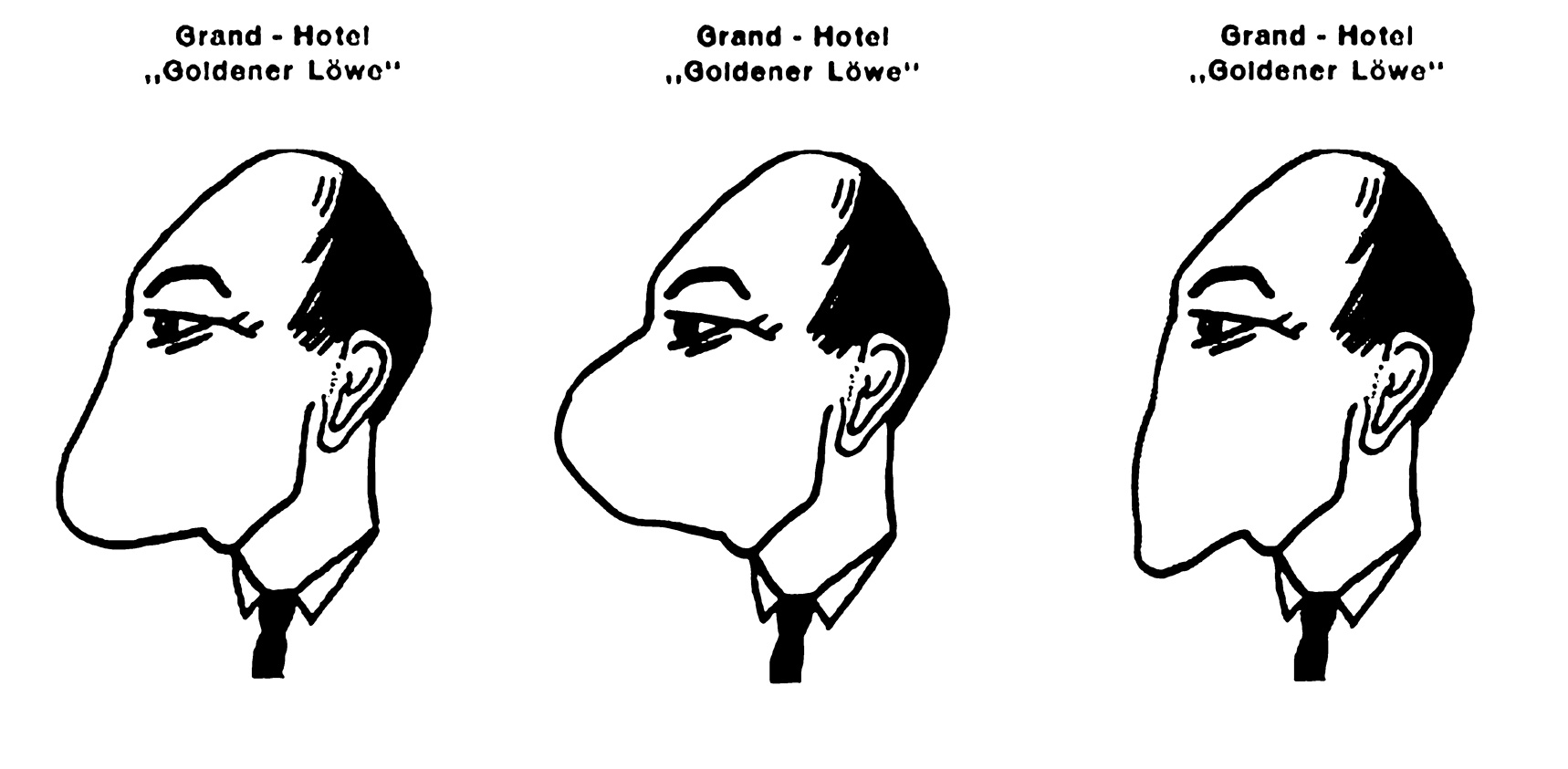
After the Revolution, with its fascination with corpses and scorn for vegetable scents, the return of musk took on a symbolic value. Sprinkled with eau de cologne, drenched in vapors from animal perfumes, the imperial couple broke with rose water. The Restoration also expressed itself in terms of smell. In this respect the faubourg St.-Germain evinced the morbid sensitivity of a chlorotic girl. Vegetable perfumes reimposed their delicacy; their function was to dampen the female impulses and to signal a new system of control.
—Alain Corbin, The Foul and the Fragrant: Odor and the French Social Imagination (Cambridge, MA: Harvard University Press, 1986.)
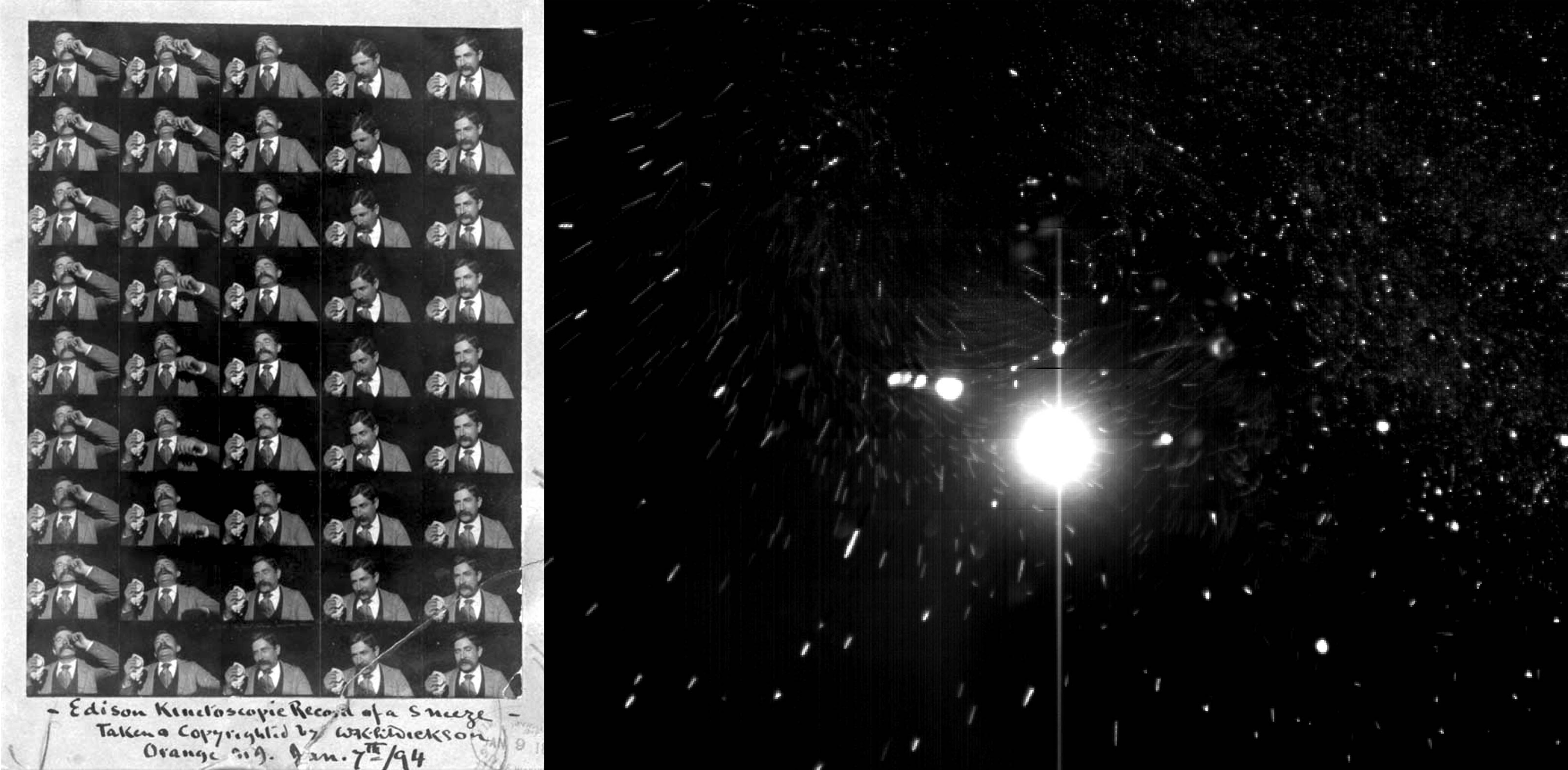
From the late eighteenth into the nineteenth century, [some] physicians … believed that certain emitted odors were evidence of diseases and illnesses, a notion that dated back to the time of Hippocrates. Revealing as they do important chemical alterations, and varying widely according to the nature and degree of organic change, odors—especially that of sweat—were even sometimes symptomatic of certain mental illnesses, circa the 1880s. Nauseating and penetrating, the smell of madness, it was believed, was evocative of clenched hands, the wild beast, the mouse. … So characteristic was it that some psychiatrists would not hesitate to diagnose a person emitting it as insane or, conversely, to conclude that a person who did not produce such an odor was faking.
—Annick Le Guérer, Scent: The Mysteries and Essential Powers of Smell, trans. Richard Miller (London: Chatto & Windus, 1992).
And he wove him a wondrous Nose,—
A Nose as strange as a Nose could be!
Of vast proportions and painted red,
And tied with cords to the back of his head.
—In a hollow rounded space it ended
With a luminous Lamp within suspended,
All fenced about
With a bandage stout
To prevent the wind from blowing it out;—
And with holes all round to send the light,
In gleaming rays on the dismal night.
And now each night, and all night long,
Over those plains still roams the Dong;
And above the wail of the Chimp and Snipe
You may hear the squeak of his plaintive pipe
While ever he seeks, but seeks in vain
To meet with his Jumbly Girl again;
Lonely and wild—all night he goes,—
The Dong with a luminous Nose!
And all who watch at the midnight hour,
From Hall or Terrace, or lofty Tower,
Cry, as they trace the Meteor bright,
Moving along through the dreary night,—
“This is the hour when forth he goes,
“The Dong with a luminous Nose!
“Yonder—over the plain he goes;
“He goes!
“He goes;
“The Dong with a luminous Nose!”
—Edward Lear, “The Dong with a Luminous Nose,” in Edward Lear, Laughable Lyrics: A Fourth Book of Nonsense Poems, Songs, Botany, Music, &c. (London: Robert John Bush, 1877).
1 Upper jawbone of a moose
1 Onion, sliced
1 Garlic clove
1 tb Mixed pickling spice
1 ts Salt
1/2 ts Pepper
¼ c Vinegar
1. Cut the upper jawbone of the moose just below the eyes.
2. Place in a large kettle of scalding water and boil for 45 minutes.
3. Remove and chill in cold water.
4. Pull out all the hairs—these will have been loosened by the boiling and should come out easily (like plucking a duck).
5. Wash thoroughly until no hairs remain.
6. Place the nose in a kettle and cover with fresh water.
7. Add onion, garlic, spices and vinegar.
8. Bring to a boil, then reduce heat and simmer until the meat is tender. Let cool overnight in the liquid.
9. When cool, take the meat out of the broth, and remove and discard the bones and the cartilage. You will have two kinds of meat, white meat from the bulb of the nose, and thin strips of dark meat from along the bones and jowls.
10. Slice the meat thinly and alternate layers of white and dark meat in a loaf pan.
11. Reheat the broth to boiling, then pour the broth over the meat in the loaf pan.
12. Let cool until jelly has set. Slice and serve cold.
—Northern Cookbook, ed. Eleanor A. Ellis (Toronto: McClelland & Stewart, 1999).
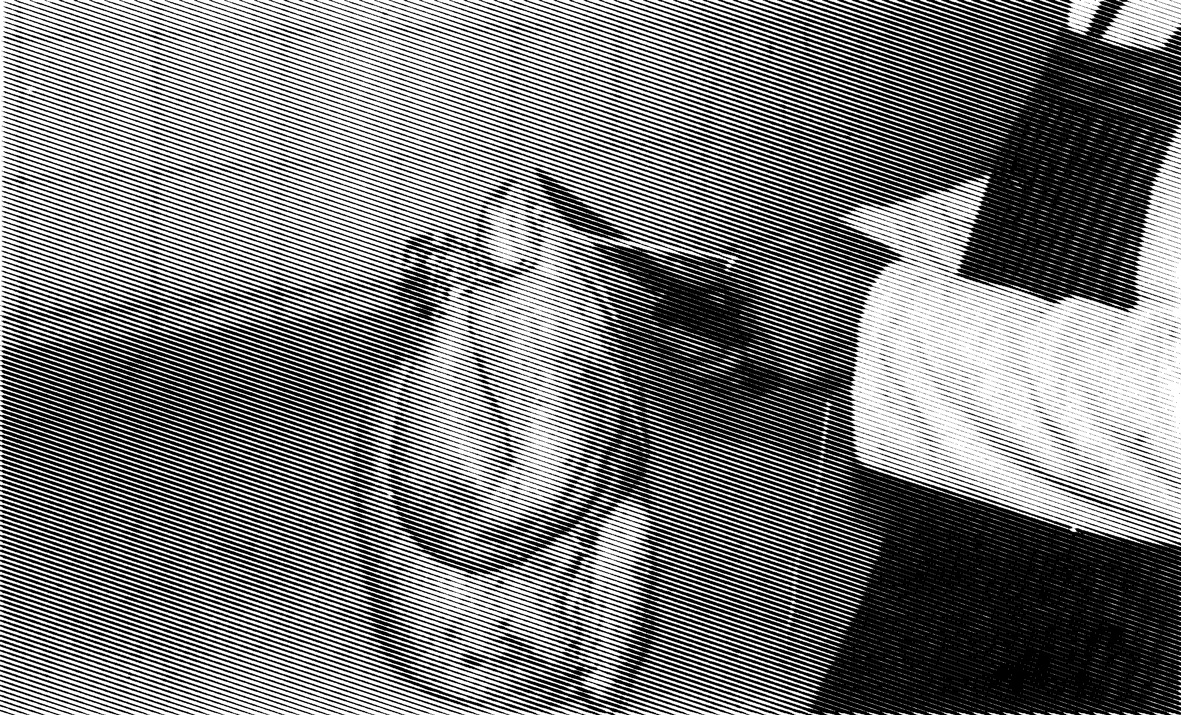
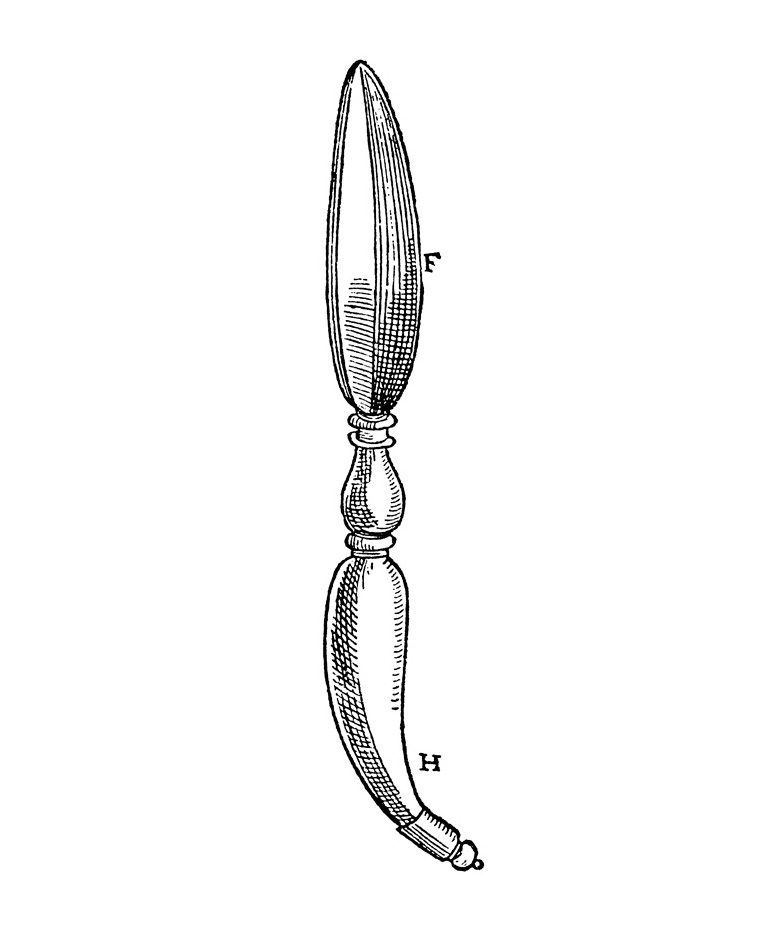
Prehistoric Art is a very conventional art, and it had its own canon of male beauty. We now have sufficient examples to prove that the male profile was rendered by exaggeratedly stressing the line of the nose. In some cases (for example, the slab at Angles-sur-l’Anglin), the nose is merely up-tilted or even bulbous; on a plaquette from La Marche the profile, still recognizably human, shows a very long, almost horizontal nose, which gives the whole of the lower part of the face an exaggerated protrusion; finally, in several other figures, the whole face is elongated until it looks like an animal’s snout or muzzle behind the nasal appendage. The resulting profile is very like that of the statuettes from the Solomon Islands. We have enough Paleolithic female statues and engravings to know that women were not subjected to this peculiar stylization, and we have enough men represented with this snout and with unmistakable signs of their sex to conclude that the snout characterizes male figures.
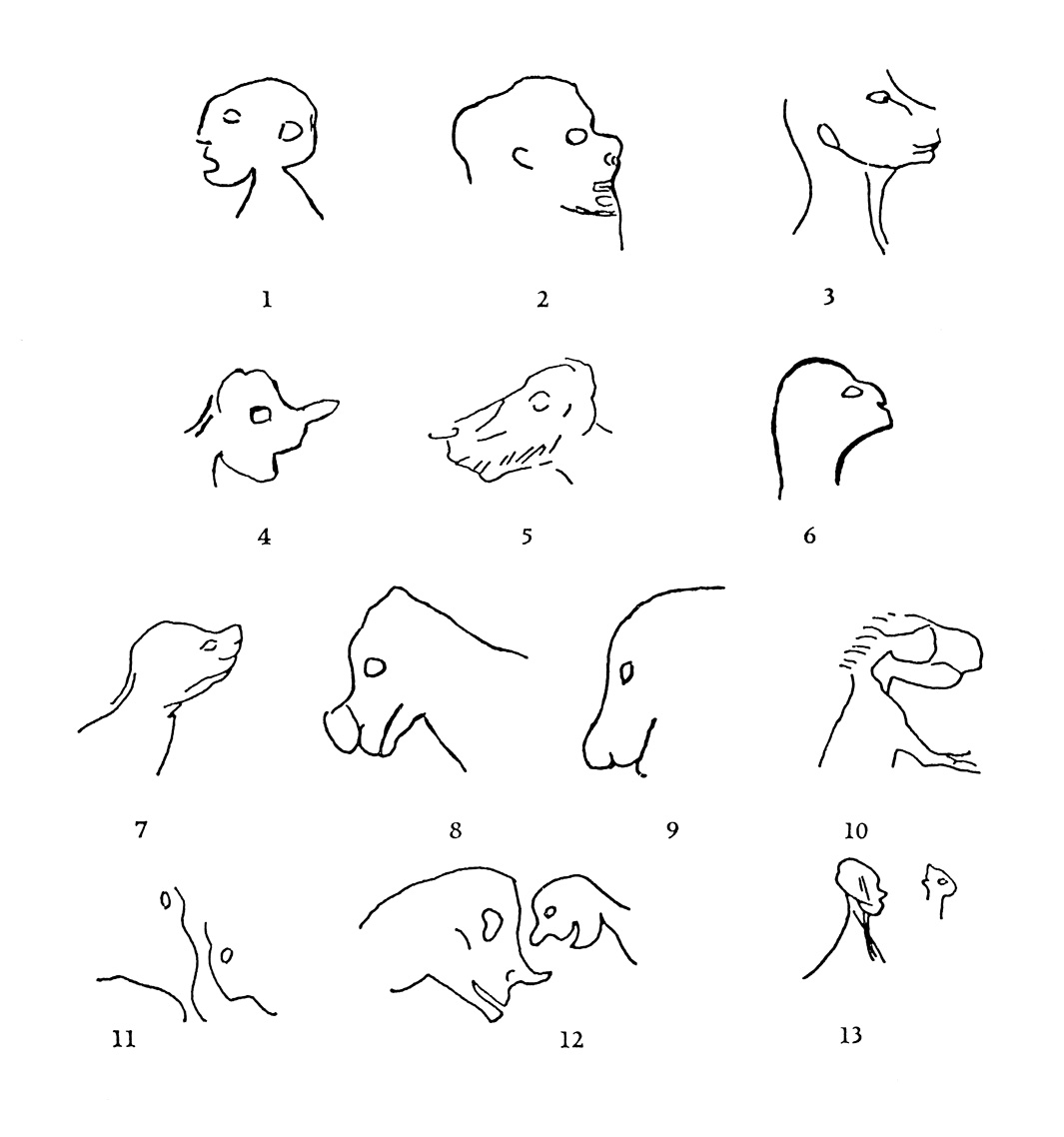
—André Leroi-Gourhan, The Art of Prehistoric Man in Western Europe, trans. Norbert Guterman (London: Thames & Hudson, 1968).
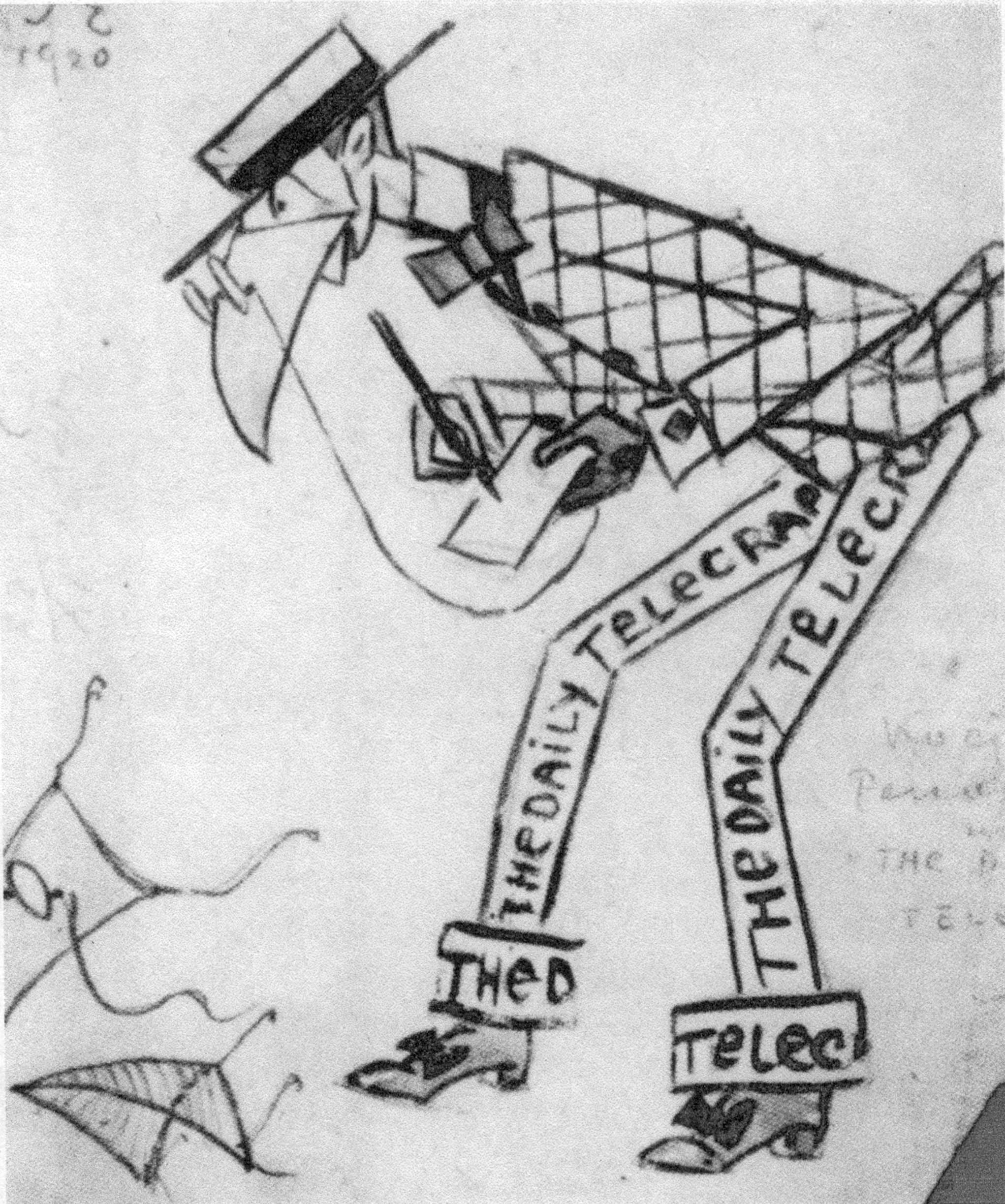
Implicasphere is an occasional publication. Past editions include “String,” “Mice,” and “Folly,” commissioned by PEER.
For orders and information visit www.implicasphere.org.uk [link defunct—Eds.] or email info@implicasphere.org.uk.
Texts have been reproduced as they appear in original publications. Idiosyncrasies and house styles have been largely left intact. Considerable effort has been made to trace and contact copyright holders and to secure replies before publication, but this has not been possible in all instances, particularly with old material. We apologize for any inadvertent errors or omissions. If notified, the editors will endeavor to correct these at the earliest opportunity.
Implicasphere is edited by Cathy Haynes and Sally O’Reilly.
Supported by the Moose Foundation for the Arts and the Elephant Trust.
Thanks to Cabinet, New York.
Designed by Fraser Muggeridge studio.
Printed in an edition of 13,000 on Cyclus Offset (recycled).
Copyright Implicasphere Ltd, London, 2006. Registered company no. 5757303.
Spotted an error? Email us at corrections at cabinetmagazine dot org.
If you’ve enjoyed the free articles that we offer on our site, please consider subscribing to our nonprofit magazine. You get twelve online issues and unlimited access to all our archives.